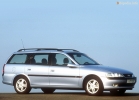Protection of the driver and passenger

Frosting, driver |

Front Punch, Passenger |

Side blow, driver |
 | - | Fine |
 | - | Good |
 | - | Satisfactorily |
 | - | Badly |
 | - | Very bad |
|
Children's holding devices
| Child up to 18 months |
No information |
| Child older than 3 years |
No information |
Safety pedestrians
 |
 | - | Fine |
 | - | Good |
 | - | Satisfactorily |
|
Comments:
During the frontal impact there was a crumpled recess, and with a side driver, the driver was risky to get a chest injury: the car did not comply with safety requirements for side shocks introduced in the EU in October 1998. The value of the shift of the steering column inside the cabin was also disturbed by experts. However, with lateral strike, the head and the driver's pelvic area was good.
Front punch:
The left front stand shifted back only 57 mm, and the passenger interior retained structural integrity. The driver's door could not normally open due to damage to the handle. The passenger door almost did not suffer. The steering wheel shifted back by 58 mm and up to 82 mm. The defection of the deepening for the legs was insignificant, the brake pedal shifted back by 134 mm. An assessment for the protection of the head was reduced due to the shift of the steering wheel. It could entail an even greater danger when placing a higher or low driver driving. The neck is well protected. Passive security systems have been lost to the breast cell of the driver from contact with the steering wheel, although the load transmitted by the seat belt represented some risk of damage. Protecting the knees, the legs and the pelvis is recognized as good, however, a low estimate for protecting the leg of the left leg is exhibited. Crumpled of the leg recesses led to a decrease in the estimate for the protection of the feet and the ankles. The overall protection of the front passenger is good, although the load, from the belt seat belt, were dangerous for the chest.
Security of passenger children:
Explanations on stickers are not clear, but the attached instruction was better.
Side strike:
Protection of the head and the driver's pelvis is good, but the sensors in the body mannequin have shown that because of the lateral impact of the car, the chest could get serious injuries, including life-threatening. The abdominal department also underwent attempt loads.
Pedestrian safety:
Child's head protection. Only one of the six checkpoints corresponded to the regulatory requirements - above the edge of the hardness of the hood. Two more points provided protection better than average, and one was close to the performance of the standard. Three points turned out to be worse than medium: above the tank coolant tank, over a air filter and above the shock absorber. Protection of the top of the legs. None of the three control points corresponded to the requirements. All places in the front edge of the hood protected better average. Adult head protection. No point corresponded to the standards. Four turned out to be better than average: over the janitor, near the washer nozzle, over the edge of the engine compartment partition and one point on the roof of the hood. Protection of legs. No point corresponded to security requirements.
General information about the car
| Roelf location |
On right |
| Tested model |
Opel Vectra 1.8i. |
| Body type |
5-door hatchback |
| Year of data publishing |
1997 |
| Curb weight |
1300 |
Safety systems:
| Pretensels of front seat belts |
There is |
| Front Belts Load Loaders |
No |
| Driver Front Airbag |
There is |
| Passenger Front Airbag |
No |
| Side airbags |
No |
| Side Head Airbags |
No |
| Driver's knees and feet airbag |
No |











